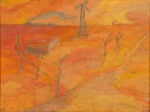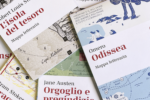Alice in Wonderland

Per la stagione estiva 2017 Officine Saffi presenta una mostra corale promossa dal centro internazionale di ricerca ceramica danese Guldagergaard.
Comunicato stampa
Per la stagione estiva 2017 Officine Saffi presenta una mostra corale promossa dal centro internazionale di ricerca ceramica danese Guldagergaard.
In mostra Stephen Bowers, Jim Cooper, Malene Hartmann Rasmussen, Sergei Isupov, Sten Lykke Madsen, Kadri Pärnaments, Mara Superior, Lileng Wong.
"Ma io non voglio andare fra i matti", osservò Alice.
"Oh, non hai altra scelta," disse il Gatto :"Qui siamo tutti matti. Io sono matto. Tu sei matta."
"Come lo sai che sono matta?" Disse Alice.
"Per forza," disse il Gatto: "Altrimenti non saresti venuta qui."
– Lewis Carroll, Le avventure di Alice nel Paese delle Meraviglie
Quando uscì Alice era il 1865, a un dipresso il momento in cui la riflessione sull’arte e la sua pratica avevano iniziato a erodere programmaticamente i concetti di verosimiglianza e di racconto, cioè di riferimento coerente a un mondo inteso come coerente, e ciò avveniva tanto per le vie esteriori del revival medievale per cui altrimenti s’intendeva “quella specie di strana formosità deforme e deformità formosa”, quella “così grande e così strana varietà di forme eterogenee” (così Bernardo di Clairvaux), tanto per le vie interne della riflessione, ormai pronta a rivendicare al territorio dell’artistico autonomie che ne riguardavano gli stessi fondamenti spazio/temporali, facoltatività in grado di produrre senso anziché trascrivere quello apparente. Non è un caso.
Il mondo di Alice è un’idea di realtà scardinata, mobile, fastosamente suggestiva, che vale ben più della sua stessa fabula.
Il gioco all’apparenza lieve e désengagé proposto dalla mostra “Alice in Wonderland”, concepita in seno al centro internazionale di ricerca ceramica danese Guldagergaard e passato alle Officine Saffi, mira a un duplice scopo. Il primo è sollecitare otto autori diversi, scalati anagraficamente tra il 1937 e il 1973 e geograficamente dalla Danimarca alla Malesia, dalla Nuova Zelanda agli Stati Uniti, a misurarsi con il testo carrolliano deducendone riflessioni diverse, da iconografiche a concettuali. Il secondo è, attraverso questa provocazione che alla prima appare epidermica, provocarli a dichiarare il grado d’intendimento del carrolliano “we’re all mad here” che è dell’arte tutta, forma preziosa di madness laddove si sottragga dalle forme stantie dell’ordinario: una riflessione e una dichiarazione dunque sul proprio essere artisti, sul proprio disciplinare sentirsi ceramisti.
Stephen Bowers (Australia, 1953) apparecchia un gioco di scacchi abitato da figure calate tutte nell’immaginario caricaturale della tradizione popolare.
Jim Cooper (Nuova Zelanda, 1956) assume la posizione più radicale: il suo è una sorta di presepe grottesco in cui iconografie basse e costeggiamenti kitsch postmoderni esibiscono con orgoglio brutale la propria spavalda evidenza.
Malene Hartmann Rasmussen (Danimarca, 1973) muova dall’appropriatezza tecnica e formale per approntare visioni all’apparenza ordinarie, confortevoli, ma in realtà nutrite d’un gioco continuo di eccezioni significative.
Più fantasticante e stylé è il lavoro di Sergei Isupov (Russia, 1963), mentre Kadri Pärnaments (Estonia, 1968) usa la chiave della pertinenza iconografica, ivi compresa la citazione diretta della tradizione illustrativa, ma in un montaggio saporoso e straniato.
Sten Lykke Madsen (Danimarca, 1937), certo nutrito a suo tempo dell’abbreviazione espressivamente brusca di CoBrA e dintorni nonché di suggestioni distillate d’art brut, mette in scena un teatrino di figure diverse, accogliendo a pieno la significazione specifica delle singole schegge narrative ed espandendola in chiave d’umore postsurreale.
Mara Superior (Stati Uniti, 1951) assume la chiave del jeu d’enfants, d’uno straniato e reinventato gusto per i bibelots, quasi in omaggio al tempo e al luogo in cui Alice storicamente nasce.
Lileng Wong (Malesia, 1967) sceglie la chiave d’un immaginario dolce e infantilmente confidente.
Si tratta dunque di posizioni divaricatissime, le quali tutte indicano che si tratta, bon gré mal gré, approcci di tipo iconografico: ma dove la vera materia problematica è non il pretesto carrolliano, bensì la centralità del poter figurare della ceramica.
OFFICINE SAFFI:
Officine Saffi è un centro specializzato nella ceramica contemporanea. Il progetto comprende la Galleria dedicata all’arte ceramica con mostre di artisti contemporanei e maestri del passato. Il Laboratorio dove sono organizzati corsi e workshop, oltre a produzioni di artisti e designer, le Residenze d’artista e la Casa Editrice che pubblica la rivista trimestrale specializzata La Ceramica in Italia e nel mondo (www.laceramicainitalia.com) e cataloghi d’arte. Infine, completa il progetto, il concorso internazionale Open to Art, dedicato alla Ceramica contemporanea d'Arte e di Design.
GULDAGERGAARD:
Guldagergaard è un centro internazionale di residenze d’artista il cui scopo primario è quello di promuovere la ceramica come forma d’arte. Il centro è un'istituzione senza scopo di lucro finanziata dal Ministero della Cultura danese e la municipalità di Slagelse. Guldagergaard ['Gool-aya-goh'] significa Fattoria dell’acro; era una fattoria di frutta di proprietà della stessa famiglia per quasi 100 anni. Nel 1997 è nato il Centro Internazionale di Ricerca Ceramica Guldagergaard il cui obiettivo è tuttora quello di offrire agli artisti internazionali laboratori ben attrezzati e personale tecnico pronto ad aiutare e a trasformare le loro visioni in argilla.
For the 2017 Summer Season, Officine Saffi presents a chorus-like exhibition promoted by the Danish International Ceramic Research Centre, Guldagergaard. On show Stephen Bowers, Jim Cooper, Malene Hartmann Rasmussen, Sergei Isupov, Sten Lykke Madsen, Kadri Pärnaments, Mara Superior and Lileng Wong.
“But I don’t want to go among mad people," Alice remarked.
"Oh, you can’t help that," said the Cat: "we’re all mad here. I’m mad. You’re mad."
"How do you know I’m mad?" said Alice.
"You must be," said the Cat, "or you wouldn’t have come here.”
- Lewis Carroll, Alice’s Adventures in Wonderland
Alice in Wonderland was first published in 1865, in a period in which reflections on art had begun to erode the concepts of realistic depiction and narrative, in other words the references to a coherent, ordinary world. This occurred both for the exterior traits of the Medieval revival, equated with “that strange sort of deformed sculpture and sculptural deformity,” that “thing so large, so strange a collection of different forms” (in the words of Bernardo di Clairvaux), and for the interior paths of reflection. The time was ripe for art to claim its own independent use of the very foundations of space and time, and the fact that it was up to the artist to decide whether he or she wanted to create new meanings rather than transcribing existing meanings. This is no coincidence. The world of Alice is an alternative, mobile form of reality, elaborately evocative, whose value far exceeds that of just the fable.
The apparently light-hearted and non-committal game presented in the exhibition “Alice in Wonderland”, which originated at the Guldagergaard International Ceramic Research Centre in Denmark and that was later shown at Officine Saffi, has a dual role. The first was to invite eight different artists, born on dates varying from 1937 to 1973 in different locations including Denmark, Malaysia, New Zealand and the United States, to work on Carroll’s text, developing various reflections on it, from iconographical to conceptual. The second objective was to use this provocative approach, which at first sight seems merely skin deep, to stimulate them to declare their degree of agreement with Carroll’s statement “we’re all mad here.” It can be applied to the whole of art, which after all is a precious form of madness, in which you can escape from the tired forms of the ordinary. The participants were thus invited to produce a reflection and a declaration on their own status as artists, and more specifically their identity as ceramists.
Stephen Bowers (Australia, 1953) lays out a game of chess inhabited by figures immersed in the caricature-like world of popular tradition.
Jim Cooper (New Zealand, 1956) adopts the most radical position: his interpretation is a sort of grotesque nativity scene in which lewd iconography and kitsch postmodern juxtapositions are displayed with brutal, bold, provocative presence.
Malene Hartmann Rasmussen (Denmark, 1973) starts from appropriate technical and formal values to create visions that are at first sight ordinary and reassuring, but that in actual fact are fuelled by a constant interplay of significant exceptions.
Work by Sergei Isupov (Russia, 1963) is closer to a stylized fantasy, while Kadri Pärnaments (Estonia, 1968) uses an approach of iconographical relevance, including the direct citation of the illustrative tradition, though in a flavoursome, alienated montage.
Sten Lykke Madsen (Denmark, 1937), who without doubt drew inspiration from the brusque expressive abbreviation of CoBrA and its circles, along with distilled suggestions of art brut, stages a theatre of different personalities, encompassing the specific meaning of the individual shards of narrative and expanding them into a post-surreal feeling.
Mara Superior (United States, 1951) adopts the approach of the jeu d’enfants, with an alienated, reinvented taste for bibelots, almost a tribute to the time and place in which Alice first appeared.
Lileng Wong (Malaysia, 1967) works on a gentle imagery with traits of infantile intimacy.
So, very different expressions, though all of them are, like it or not, iconographical approaches. However, the fundamental concern is not so much Carroll as a pretext, but rather the figurative power of the ceramic medium.
OFFICINE SAFFI:
Officine Saffi is a centre dedicated to contemporary ceramics. The project includes the Gallery specializing in ceramic art, with exhibitions of work by contemporary artists and master ceramists of the past; the Workshop, used for courses and practical work, as well as for production by artists and designers and during Artists’ Residencies; and the Publishing House, which produces the specialist quarterly magazine La Ceramica in Italia e nel mondo (www.laceramicainitalia.com) and art catalogues. The project is completed by the Open to Art international competition, dedicated to contemporary art and design ceramics.
GULDAGERGAARD:
Guldagergaard is an international artist-in-residence center for professional artists and it’s purpose is to promote ceramic as an art form. The centre is a non-profit institution with state funding from the Danish Ministry of Culture and the municipality of Slagelse. Guldagergaard ['Gool-aya-goh'] means Golden Acre farm and has been the name of this place for more than a century. It used to be a fruit farm owned by the same family for nearly 100 years. In 1997 the International Ceramic Research Center Guldagergaard was established and it’s goal is still to offer international artist-in-residence, well equipped studios and technical staff ready to help to put their visions into clay.



